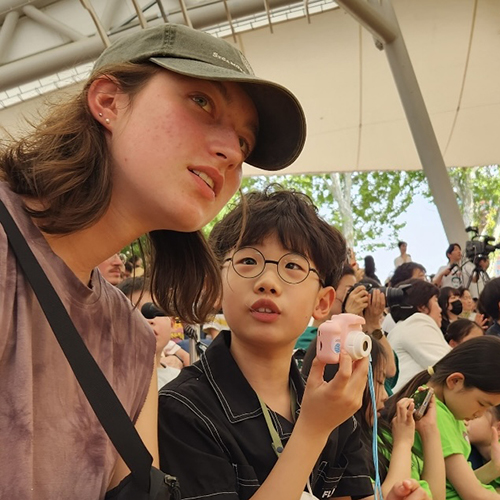In a corner of Odegaard Library, a UW sophomore hunkers down with a collection of Superman comics. It might seem that he’s avoiding his class assignments, but in fact this is an assignment. By the end of the quarter, he and his classmates will work their way through Batman, Wonder Woman, Watchman, and a slew of other superhero comics for a 200-level English course, Superheroes.
“There is so much media interest in superheroes, so many movies and TV shows,” says Tom Foster, professor of English, who teaches the course. “I’m trying to show the complexities of the culture that those films and TV shows are drawing on.”
Foster has read more than his fair share of superhero comics and finds the genre ripe for exploration. He decided to devote a course to the topic after teaching courses on science fiction and fantasy novels. “There is a long tradition of science fiction stories about the ‘superman’ idea — evolutionary fantasies about the future development of the human race, mutants for example,” says Foster. “I got interested in how that fiction influenced superhero comics.”

The first successful comic book superhero, Superman, was created by avid science fiction fans Jerry Siegel and Joe Shuster for DC Comics in 1938. The appeal was immediate. “Superman is actually a rather complex character,” says Foster. “He faces problems of fitting into the culture to which he has immigrated — a familiar problem — but he also has special powers. That’s a key tension. People respond to both the relatability of Superman and this imagining of new modes of existence, new abilities, which is the science fiction part of it.”
The publication of Superman ushered in the ‘Golden Age’ of comics, a 16-year period during which such mainstays as Batman, Wonder Woman, and Captain America were introduced, their stories unfolding in serial comics each month. “The comics, especially during this period, were very much about the repeating of stories, with everything starting over again each month,” says Foster. “There were no ongoing consequences. It wasn’t until much later, in the 1980s, that we start to see superheroes in graphic novels with a beginning, middle, and end.”
Superheroes, especially superhero comics, are informed by rather complex structures of meaning. They are not straightforward, cardboard cartoon characters.
In class, Foster discusses how superhero stories have always been influenced by current events. Superman’s creators, for example, had to distance themselves from Nazi rhetoric about a ‘super man’ or superior race. “As depression-era Jewish kids from Cleveland, they were quite self-conscious about that,” says Foster. “They didn’t want people reading their superhero as a Nazi icon. They handled that by emphasizing Superman’s immigrant narrative. Raised in small town American, Superman assimilated to American small-town values. That’s there to reassure people that he’s not the Nazi version of the superman idea.”
Wonder Woman, introduced in 1940, is another interesting case. Created by a man as a feminist superhero, she fights misogynistic villains who are trying to keep women from working in factories during the war. The comics often end with her lecturing that women should be strong and not dependent on men. “Wonder Woman was quite popular,” says Foster. “We read the stories now and they seem politically explicit and surprisingly radical in retrospect.”
In the mid-1950s, a censorship scandal and concerns that comic books promoted juvenile delinquency led many comic book publishers to go out of business. Those that remained published sanitized stories where good always won, no one was ever killed, and there was a clear moral at the end of the story. “Superheroes during this period were less about fighting crime and more about having fantastic adventures,” says Foster. “Even Batman, an urban vigilante character, became more of a fantasy character. That’s the version that leads to the Batman television show in the 1960s, rather than the earlier, scarier vigilante Batman.”

It would be another decade before Marvel Comics introduced more realistic and novelistic stories, spawning a new generation of superheroes. These characters faced real family problems and lived in places like New York City rather than fictional Metropolis or Gotham. That led to the publications like Watchmen and Batman: The Dark Knight Returns in the mid-1980s, which presented more sophisticated updatings of the superhero.
Foster’s students read the historically important Watchmen, then dive into more recent fare that continues to stretch the genre, including graphic novels that explore questions of diversity and social difference. They read the series Icon, published in the 1990s by Milestone Comics, an independent imprint created by African-American writers and artists. In this retelling of the Superman story, Icon is a conservative African-American lawyer and superhero challenged to reconnect with the African-American community. “The Milestone Comics were all Black and multicultural retellings of superhero conventions,” says Foster. “They used superheroes to write about questions of race in the U.S. in a very explicit way. They also argued that Black characters should be created by Black writers and artists.” Foster also assigns Ms. Marvel, a more recent book in which the superhero is a Pakistani-American woman.
As the superhero genre continues to evolve, Foster welcomes the opportunity to examine comics and graphic novels through an academic lens. “There is value in the academic study of popular materials that are usually viewed as entertainment,” he says. “Superheroes, especially superhero comics, are informed by rather complex structures of meaning. They are not straightforward, cardboard cartoon characters. There are critical possibilities in examining these popular works.”
More Stories

Democracy by the Numbers
Mathematics and Democracy, an undergraduate mathematics course, explores the role of math in many aspects of democracy, from elections to proportional representation.

Finding Family in Korea Through Language & Plants
Through her love of languages and plants — and some serendipity — UW junior Katie Ruesink connected with a Korean family while studying in Seoul.

Dancing Across Campus
For the dance course "Activating Space," students danced in public spaces across the University of Washington's Seattle campus this spring.